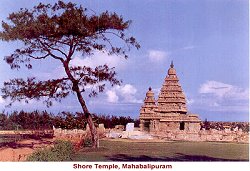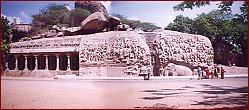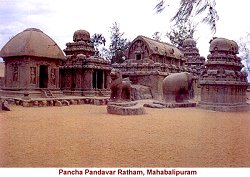|

Mahabalipuram
Mahabalipuram, a coastal town 64 kms from Chennai
is a scultpor's delight. Mahabalipuram, is now known as Mamallapuram. It
is believed to have been called Mahabalipuram after the great king Mahabali, who
was blessed by Lord Vishnu in his Vamana Avataram. It is known as
Mamallapuram after the Pallava king Narasimhavaramn I, who bore the title of
Mamallan (great wrestler). The major contributions were by the Pallava
rulers Narasimha Varman & Rajasimhan. The earlier works were rock cut
temples & manadapams, while during the period of Rajasimhan they were
structural constructions.
Shore Temple
The shore temple is located at the sea shore and has withstood the ravages of
the sea. Unlike the rock cut structures in Mamallapuam, this is a
structural temple, built by Rajasimha out of hard blackish leptinite. This
shrine is dedicated to both Siva and Vishnu. There are two vimanas,
Ksatriyasimheswara facing east and the smaller Rajasimheswara facing west
dedicated to Lord Siva. The Vishnu griha is a mandapa between these two
called the Narapatisimha Pallava Vishnugriha. The names of these shrines
are the various titles of Rajasimha.
The shrines have a square lower storey and a pyraidal superstructure. The
tower is more tapering than the monolithic structures.A sixteen sided polished
Siva Linga - in the bigger shrine. There are Somaskanda panels in the rear
walls of the Siva shrines.
Arjuna's Penance
 This
bas relief, is an extensive panel (27 metres long & 9 metres high of relief
sculptures, with life size images. There are two beliefs as to the them of
the sculptures. Arjuna, one of the Pandava brothers is said to have done
penance asking for a powerful weapon with which to destroy his enemies. The huge gathering of celestials and humans witness the great scene. This
bas relief, is an extensive panel (27 metres long & 9 metres high of relief
sculptures, with life size images. There are two beliefs as to the them of
the sculptures. Arjuna, one of the Pandava brothers is said to have done
penance asking for a powerful weapon with which to destroy his enemies. The huge gathering of celestials and humans witness the great scene. 
According to the second belief, it is
Bhagiratha's penance to get river Ganges down to the earth. His prayers are
answered and Lord Shiva sends the Ganges down to the earth, controlling its
rapid flow by allowing it to trickle from his matted locks. The natural
cleft in the rock face depicts the flow of Ganga, watched over by celestials and
humans. There are several images of animals too.
Pancha Pandava Rathams
The five rathas are mini shrines which are carved
out of one rock constructed in the form of chariots. The Dharmaraja, Bhima,
Arjuna & Draupadi rathams have been carved out of one single boulder. Draupadi and Arjuna rathams have a common platform.
The rathams are modeled on different architectural styles:
the Buddhist Viharas - Dharmaraja; Arjuna; & Nakula, Sahadeva's rathams
the Buddhist Chaityas - Vessera style - Bhima's ratham with longitudinal
structure, barrel roof
modern Bengali huts - Draupadi's ratham with a square cell, curvilinear roof.
The Dharmaraja ratham has a three storeyed
vimana.
In the Draupadi ratham, the image of Draupadi is
carved on the inside. On the rear wall of the Arjuna ratham is the image
of Indra. There is a huge elephant and lion carved out near the rathams.
These rathams are characterised by open verandahs
in the ground storey, with typical Pallava style pillars. The
pillars have crouching lion bases. These five rathams are in one spot. There are
three more rathams Valayankuttai, Pidari and Ganesha rathams.
The later southern temples have been largely
influenced by the Dharmaraja & Arjuna ratham styles.
Top
|
|



